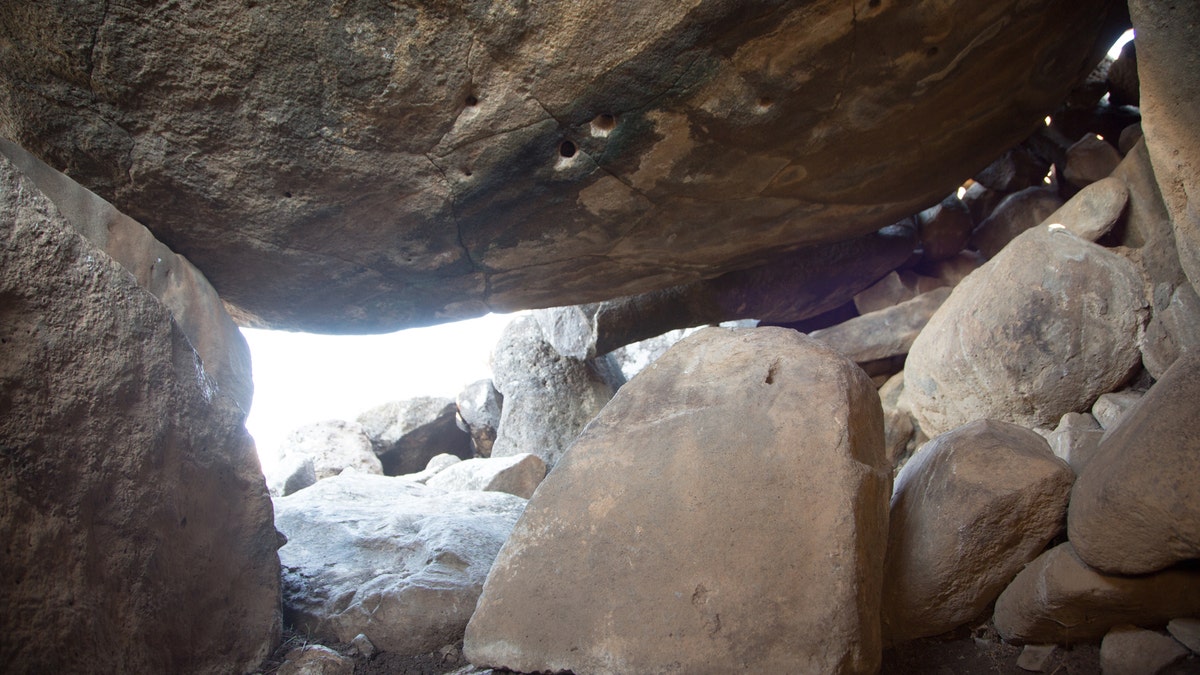
The view from inside the dolmen. (Photographic credit: Shmuel Magal, courtesy of the Israel Antiquities Authority)
Archaeologists in the Upper Galilee region of Israel have uncovered a huge dolmen — a large flat stone that is laid upon upright ones, like a table top — that they say contradicts theories about the sophistication of civilization more than 4,000 years ago, during the “middle ages” of the Bronze Age.
The stone covers an area that is 10 feet wide and 6½ feet long, and it weighs an estimated 50 tons. It is one of more than 400 huge stone structures located in a field next to a kibbutz, but it is the first dolmen ever found that has drawings engraved on its underside.
“This is the first art ever documented in a dolmen in the Middle East,” said Uri Berger, an archaeologist with the Israel Antiquities Authority, which uncovered the stone in partnership with Tel Hai College and the Hebrew University of Jerusalem. Their study was published March 2 in the scientific journal PLOS One.
“The engraved shapes depict a straight line going to the center of an arc,” Berger said. “About 15 such engravings were documented on the ceiling of the dolmen, spread out in a kind of arc along the ceiling.
SCIENTISTS ISSUE DIRE WARNING ABOUT TOMB OF JESUS
“No parallels exist for these shapes in the engraved rock drawings of the Middle East, and their significance remains a mystery.”
The dolmen was discovered within an enormous heap of stones that weigh an estimated 400 tons, and it has at least four smaller dolmens positioned at its foot. “In other words,” Berger said, “what we have here is a huge monumental structure built hierarchically, with a main cell and secondary cells. This is the first time such a hierarchical dolmen has been identified in the Middle East.”
FOR THE LATEST TECH FEATURES FOLLOW FOX NEWS TECH ON FACEBOOK
Archaeologists say the dolmen field could rewrite the existing theories of civilization during the Bronze Age, which is generally considered to be a “dark period” of history because it left no artifacts that would indicate the presence of cities, large settlements and buildings.
Instead, they say, the dolmens reflect a society that had a complex governmental and economic system that could undertake large engineering projects.
“The gigantic dolmen … is without doubt an indication of public construction that required a significant amount of manpower over a considerable period of time,” said Professor Gonen Sharon of Tel Hai College’s Galilee Studies Program.
“During that time, all of those people had to be housed and fed. The building of such a huge construction necessitated knowledge of engineering and architecture that small nomadic groups did not usually possess.
“And even more importantly, a strong system of government was required here that could assemble a large amount of manpower, provide for the personnel and, above all, direct the implementation and control of a large and lengthy project."








































